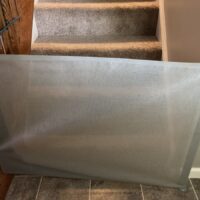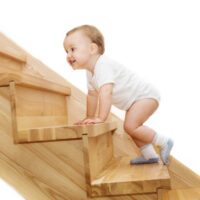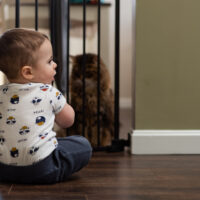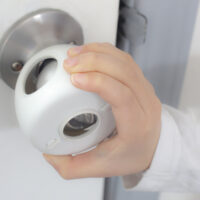A DIY baby gate can be as simple or as complicated as you make it!
It can also be as expensive as you want, depending on what you are looking for as a result. For example, if you decide to make a baby gate from PVC pipes, you’ll save money over a wood gate.
Let’s dive in – your baby isn’t getting any slower!
Steps to Build a Baby Gate
1. Measure
Before you buy one single piece of material for this project, take measurements. Using a tape measure, find the length and width of the spot you need to gate off.
Write down these measurements. Memorize the measurements. Breathe the measurements. Okay, maybe that’s too far, but at the very least, write down the measurements and take that paper with you to Home Depot.
If you’re flexible on height, most baby gates are between 24 and 28 inches. To put it in perspective, Consumer Reports recommends gates be at least three-quarters of your child’s height. The taller the gate, the longer you have before your child can climb over it!

2. Choose Materials
Pick your poison. PVC piping? Plywood? African Blackwood, the densest and most expensive lumber in the world?
That last one is probably overkill for 90% of our homes, so affordable lumber or piping will be your best bet. Still, the only limit is your imagination.
Options for Baby Gate Materials:
- Wood
- PVC piping
- Fabric
- Vinyl trellis (really!)
3. Design
Since this is a DIY job, you’ll need to design the baby gate yourself. You don’t need an engineering or architectural degree to do this! You don’t even have to put anything on paper.
This step is about visualizing what look you want. After all, if you’re going the DIY route, you likely have a style you’re hoping to achieve.
If you’re stumped, take a look around the internet. Pinterest, YouTube, or even a simple Google search can inspire you. Here’s a secret: plenty of sites even provide baby gates designs if you get stuck.
So what look do you want? If your home is a modern design and you want to match it, for example, go with clean lines and minimal detail.
On the other end of the spectrum, maybe your home is farmhouse decor. If so, consider how adorable a small barn door gate would be!
An important detail to consider: do you have any pets in the home? Do you want them to be able to pass through the gate without your assistance? With a little extra effort, your baby gate can include a dog or cat door.
Believe it or not, there are even more baby gate features. Next, you need to decide how the gate will open. You can have it slide open, fold open, or just simply swing open.
Also, consider the spacing. If your gate has slats or rails, the space between them should not be able to fit a tiny toddler head, for safety reasons.
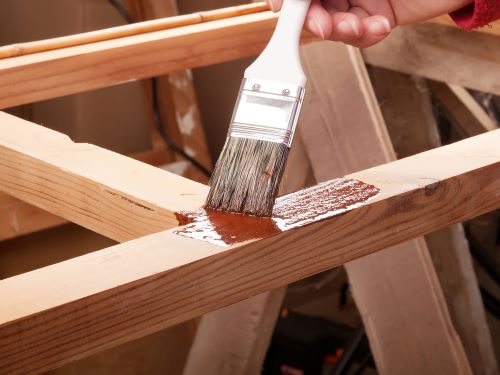
4. Build
The actual building and installing process depends on what look you decided on. It can be as easy or as complicated as you make it.
For example, installing a dutch door is probably the least intensive because you don’t have to put together the gate. If you don’t know, a dutch door is a door that is split in the middle. It’s also a popular choice as a “half door” makes for a great alternative baby gate.
If you go with a dutch door, your building step boils down to choosing a door, ordering it, and then installing it per the instructions. Using a half barn door or similar would be the same amount of work.
For other looks, a little more creativity and craftsmanship are needed. Always start with a clear open space with plenty of room. It’s best to set up your gate pieces on the floor to check the look and measurements before drilling any holes.
You’re probably familiar with traditional baby gates and their vertical slats. It’s a lot like the sides of a crib. Baby products tend to avoid horizontal bars since they can easily become a ladder for little ones.
You aren’t stuck with cage-like vertical slats though. If you prefer it horizontal, keep the bars tight together. In fact, your best to leave no room in between them at all.
If neither horizontal nor vertical rocks your world, get fancy. Diagonal slats look contemporary and cool. You can even get creative and make a gate with geometric designs.
No matter what look you choose, make sure your finished product is safe. Consumer Reports recommends all baby gates should be smooth, splinter-free, and have rounded edges. This may mean using a sander or even good old sandpaper!
Of course, don’t forget some sort of latch or lock. Some DIY instructions out there include bolt locks, but we wouldn’t recommend that. Bolt locks are easy for even little hands to maneuver.
Opt for a more complicated lock. A gate latch could be incorporated into your design and is a popular choice among DIYers. A drop rod latch is another choice seen around DIY sites.
FAQs about Baby Gates
Why Do I Need a Baby Gate?
With baby gates, I am always reminded of this skit that’s been parodied all over social media. The basic premise is that a burglar enters a home, but is thwarted by a baby gate that he can’t figure out how to open. “I’ll just pick another house,” the burglar groans to the homeowner.
Now, for legal purposes, I need to state that a baby gate won’t stop a home invader. With any luck, it will stop your little crawling bundle of joy out of undesirable areas of your home, like the kitchen or a set of stairs.
In our house, we installed a baby gate in the kitchen doorway. Our little crawler just did not need to be sneaking into the kitchen, especially since the room included exits to the garage and the backyard.
Most parents also opt to install baby gates at the top and bottom of their home’s staircases. You likely know the hazards of stairs. You might not know the numbers though. Namely, 90,000 kids visit ERs every year for stair-related falls.
Why Should I DIY a Baby Gate?
Now, I’m going to drop another truth bomb on you: mass-produced baby gates are ugly.
It’s true and you know it. We aren’t buying these for their aesthetic appeal. No thick plastic baby gate is going to brighten up your home.
For this reason, more and more parents are opting to go the DIY route with baby gates. This allows for design control. When you DIY, you can create your own custom gate that does complement your home’s interior.
Less common, but still a reality, some parents have to DIY baby gates because the area requiring one doesn’t work with traditional gates. This could be due to sizing, angles, or something else.
When should baby gates go up?
Baby gates are necessary once your baby is crawling. Technically, you should start thinking about baby gates before your baby becomes mobile. Most babies crawl around 6 months, but you may be blessed with an early mover.
Before your baby is crawling, start making baby gate plans. At the same time, don’t forget the rest of your babyproofing: outlets covers, toilet locks, and furniture anchors!
Where should baby gates be installed?
The easiest way to answer this question is to take a look around your own home. As you look, take note of the most dangerous areas. I don’t mean dangerous for you, of course, but for your little crawler.
Imagine your baby unattended and roaming your house. Wherever you feel your heart skip at the thought of a room, that’s where you need a baby gate.
For instance, my home is a one-level ranch, so no upstairs. However, we have a basement and you can access it from the kitchen. Baby gate! Also, we have a fireplace and we wanted to keep my son’s little hands out of the hearth, so we gated that area off too.
Here are the most common places for baby gates.
- Top of stairs
- Bottom of stairs
- Kitchen
- Laundry room
- Office
- Fireplace
When can baby gates come down?
There is no hard and fast rule about when to take down a baby gate. The short answer is: remove the baby gate when it isn’t useful anymore.
To elaborate, you can certainly take down a baby gate once your child has mastered opening it. At that point, it’s just an annoying obstacle for everyone in the house.
Safety is a concern though. Just like with cribs, once a baby can climb over a baby gate, it’s best to take it down. The risk of injury is just too high, especially with a set of stairs.
What about younger siblings? If a toddler is climbing the gate, but it needs to remain up for a baby, experts recommend teaching your older child to open and close the gate for themselves at that point.
How much space do you need under a baby gate?
You may be tempted to leave a gap under your baby gate so Fluffy the Kitty or Fido the Puppy can get through, but don’t do it. If a space is big enough for a pet, it’s probably big enough to entrap your child’s head.
The space underneath any baby gate should be no larger than 3 inches. That is the maximum space though – in this case, smaller is always better.
Is a baby gate going to damage my wall?
Maybe. Unfortunately, baby gates should be securely anchored to a door frame for safety, which often means drilling some holes. If you purchase a baby gate, instead of DIYing one, you could go with a pressure-mounted gate, which requires no holes, but ultimately, isn’t as safe.
No one wants to damage a perfectly good wall, but, in cases like this, we often have to bite the bullet!
Conclusion
As parents, we don’t like baby gates, but we understand they are necessary. If mass-produced baby gates don’t fit your style, though, there is always the DIY route. While it certainly isn’t the easiest option, it opens you up to many more possibilities.
If you would like to DIY a baby gate, first decide on what look and style you want. You’ll next need to take measurements and buy materials. When everything is ready, you can build that gate. After that, there’s nothing left to do but enjoy your new DIY baby gate!

